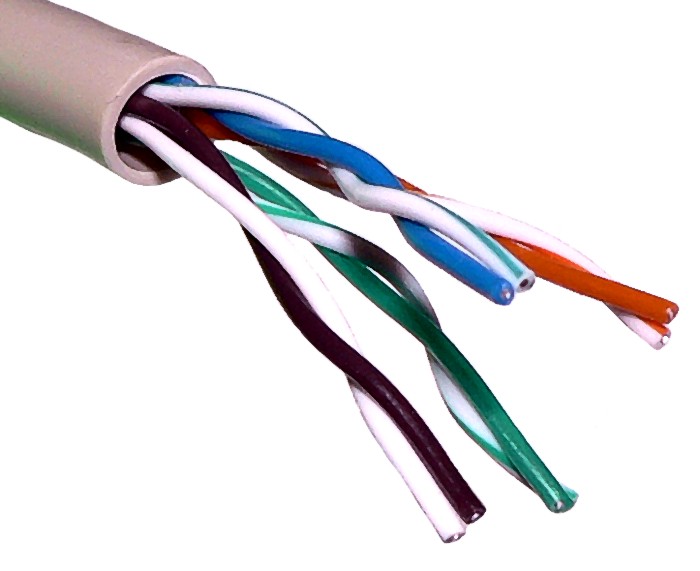UTP cables are found in many Ethernet networks and telephone systems. For indoor telephone applications, UTP is often grouped into sets of 25 pairs according to a standard 25-pair color code originally developed by AT&T Corporation. A typical subset of these colors (white/blue, blue/white, white/orange, orange/white) shows up in most UTP cables. The cables are typically made with copper wires measured at 22 or 24 American Wire Gauge (AWG), with the colored insulation typically made from an insulator such as polyethylene or FEP and the total package covered in a polyethylene jacket.
For urban outdoor telephone cables containing hundreds or thousands of pairs, the cable is divided into smaller but identical bundles. Each bundle consists of twisted pairs that have different twist rates. The bundles are in turn twisted together to make up the cable. Pairs having the same twist rate within the cable can still experience some degree of crosstalk. Wire pairs are selected carefully to minimize crosstalk within a large cable.
Unshielded twisted pair cable with different twist rates
UTP cable is also the most common cable used in computer networking. Modern Ethernet, the most common data networking standard, can use UTP cables. Twisted pair cabling is often used in data networks for short and medium length connections because of its relatively lower costs compared to optical fiber and coaxial cable.
UTP is also finding increasing use in video applications, primarily in security cameras. Many cameras include a UTP output with screw terminals; UTP cable bandwidth has improved to match the baseband of television signals. As UTP is a balanced transmission line, a balun is needed to connect to unbalanced equipment, for example any using BNC connectors and designed for coaxial cable.
Cable shielding
Main article: Electromagnetic shielding
F/UTP cable
S/FTP cable
U/FTP, F/UTP and F/FTP are used in Cat.6a cables
Twisted pair cables are often shielded in an attempt to prevent electromagnetic interference. Shielding provides an electrically conductive barrier to attenuate electromagnetic waves external to the shield, and provides a conduction path by which induced currents can be circulated and returned to the source, via ground reference connection.
This shielding can be applied to individual pairs or quads, or to the collection of pairs. Individual pairs are foiled, while overall cable may use braided screen, foil, or braiding with foil.
When shielding is applied to the collection of pairs, this is usually referred to as screening, but different vendors and authors use "screening", "shielding", and "STP" inconsistently to denote various shielded cable types.
ISO/IEC 11801:2002 (Annex E) attempts to internationally standardize the various designations for shielded cables by using combinations of three letters - U for unshielded, S for braided shielding (in outer layer only), and F for foiled shielding - to explicitly indicate the type of screen for overall cable protection and for individual pairs or quads, using a two-part abbreviation in the form of x/xTP.
Shielded Cat. 5e, Cat. 6/6A, and Cat 8/8.1 cables typically have F/UTP construction, while shielded Cat. 7/7A and Cat. 8.2 cables use S/FTP construction.[6]
Because the shielding is made of metal, it may also serve as a ground. Usually a shielded twisted pair cable has a special grounding wire added called a drain wire which is electrically connected to the shield or screen. The drain wire simplifies connection to ground at the connectors.
Common shield construction types used include:
Individual shield (U/FTP) Individual shielding with aluminum foil for each twisted pair or quad. Common names: pair in metal foil, shielded twisted pair, screened twisted pair. This type of shielding protects cable from external EMI entering or exiting the cable and also protects neighboring pairs from crosstalk. Overall shield (F/UTP, S/UTP, and SF/UTP)Overall foil, braided shield or braiding with foil across all of the pairs within the 100 Ohm twisted pair cable. Common names: foiled twisted pair, shielded twisted pair, screened twisted pair. This type of shielding helps prevent EMI from entering or exiting the cable. Individual and overall shield (F/FTP, S/FTP, and SF/FTP)Individual shielding using foil between the twisted pair sets, and also an outer foil and/or braided shielding. Common names: fully shielded twisted pair, screened foiled twisted pair, shielded foiled twisted pair, screened shielded twisted pair, shielded screened twisted pair. This type of shielding helps prevent EMI from entering or exiting the cable and also protects neighboring pairs from crosstalk.
An early example of shielded twisted-pair is IBM STP-A, which was a two-pair 150 ohm S/FTP cable defined in 1985 by the IBM Cabling System specifications, and used with token ring or FDDI networks.

